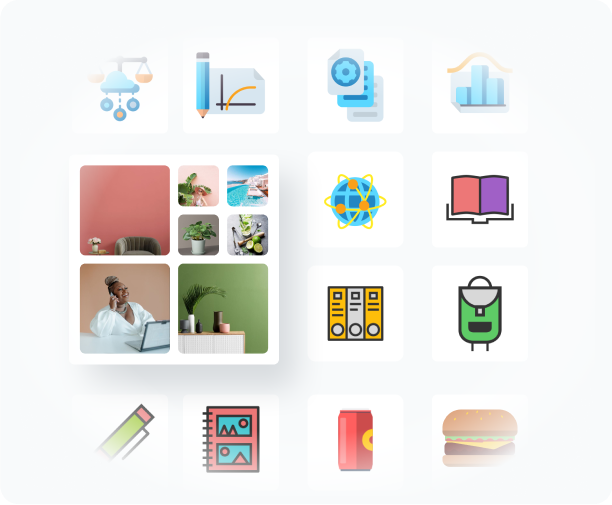- Professional Book Cover Maker for Engaging Cover Designs
- Chosen by brands large and small
- Features of the Book Cover Maker
- Beautiful book cover templates
- Build your book cover
- Customize every aspect of your book cover with your preferred font and colors
- More Great Features of the Book Cover Maker
- Share Your Book Cover
- What is a Book Cover?
- Use the book cover maker to design prize-worthy book covers quickly and easily.
- More Than a Book Cover Maker
- How to Make Book Covers in 5 Steps
- How to Use the Book Cover Maker
- Frequently Asked Questions (FAQs)
- Your book covers deserve to be beautiful and so does the rest of your content
- Top 5 Free Book Cover Makers–Don’t Break the Bank, Create Your Own!
- Table of contents
- Top 5 Available FREE Programs (ranked in no particular order)
- Krita
- Paint.net
- Canva
- Is Designing Your Own Cover Right For You?
- Format Beautiful Professional Books
- Determining The Right Software for You
- 1. Photo Collage
- 2. Templates
- 3. Text Editing
- 4. Layers
- 5. Photo Manipulation
- Words of Warning
- Branding Concerns
- Stock Photos
- In Conclusion
Professional Book Cover Maker for Engaging Cover Designs
Chosen by brands large and small
Our book cover maker is used by over 19,625,288 marketers, communicators, executives and educators from over 120 countries that include:
Features of the Book Cover Maker
Create a beautiful book cover, and make an impact on your audience with Visme’s free online book cover maker. The Visme book cover engine is filled with intuitive features and beautiful assets to help bring your vision to life.
Beautiful book cover templates
The Visme online book cover maker comes pre-loaded with templates that control the overall design of your cover. These help you create designs that stand out to your ideal readers. Simply tap the “Book Covers” category and choose from any of our free book cover design templates.
Build your book cover
Visme gives you all the capabilities you need to create a free online book cover. You can make an impact on your audience with our book cover design software. Start the process by adding text, visuals and a beautiful font to your book cover.
Customize every aspect of your book cover with your preferred font and colors
Visme’s online book cover maker is a tool that creates high quality book covers. You can easily bring a creative vision to life with no design experience needed. Choose from our selection of free fonts or upload your own, or create preset color palettes to change color schemes with a single click.
More Great Features of the Book Cover Maker
Modern, professionally designed book cover templates
The popular and beautiful fonts that communicate the genre of your book
- Easy-to-customize graphics and illustrations available in the left sidebar
Simple design tools, built for with the non-designer in mind
Experiment with existing color schemes or create your own
Export the finished book cover as high quality PDF, JPG or PNG file
Share Your Book Cover
The Visme book cover maker is built with your publishing goals in mind. When you’re done creating your cover it’s easy to export it to your publishing software of choice.
What is a Book Cover?
A cover is the first thing potential readers will see when they come across your work. It’s an opportunity to showcase what is inside. Because of this, the cover plays a crucial role of introducing the book to your audience.
We’ve all heard the saying, «Don’t judge a book by its cover.» But the truth is that we all do it anyways — so make sure your book cover is eye-catching and makes someone want to read your book.
Use the book cover maker to design prize-worthy book covers quickly and easily.
Select one of the ready-to-use templates to make book covers online. Change the text in the placeholders to reflect your award topic or event title. Add all your relevant information, and customize the fonts to match your vision.
More Than a Book Cover Maker
Visme’s easy-to-use book cover generator empowers you to design book covers fast. Learn more about the features of the book cover generator.
MAKE IT ENGAGING
Animation
For digital books, create an animated book cover design with animated icons and illustrations that grabs attention and reels your readers into learning more.
BEAUTIFY YOUR CONTENT
Images & Graphics
Choose from over a million stock photos, icons, illustrations, characters, lines, shapes and more to add stunning design elements to your book cover.
VISUALIZE NUMBERS
Charts & Data Widgets
Easily visualize numbers and data with Visme’s charts, graphs and data widgets. Add these widgets onto your book cover as additional design elements.
How to Make Book Covers in 5 Steps
Book covers are a critical component of your writing project. However, not every author has the ability to invest in expensive graphic design. Using Visme’s free book cover maker you can design a book cover in 5 simple steps.
Follow along with our quick-step tutorial below to get started creating your own stunning book cover design.
- Log in to your Visme account and click on the Printables tab on the dashboard.
- Scroll left through the icons and tap on the Book Cover icon to find a template.
- Customize the colors, add graphics and tweak the font of your book cover.
- Add the title and any additional text to your design.
- Download the completed book cover to upload to your book publishing software.
How to Use the Book Cover Maker
- Log into Visme and open the book cover maker by clicking on Printables, then choosing the Book Covers icon to browse our premade templates.
- Select the pre-designed layout that makes the most sense for your goals, or that simply is most visually appealing to you. Remember that you can customize everything or change your template inside the editor.
- Upload any visual elements like the font pairings, icons or images that you need, or browse through all of our options in the left sidebar.
- Find the right font for your book cover using our massive library or upload your preferred font into your brand kit.
- Customize the font color so it matches with your color design, and adjust the size to achieve balance.
- Use our editing grid to arrange the visuals into a balanced composition and ensure you’ve placed large enough margins to not have a cluttered design.
- Proofread any text, headings or content you’ve placed on your book cover. Double check that everything looks great and you’re satisfied with your book cover design.
- Download the finished book cover as a high resolution image or a PDF with bleed marks for printing.
Frequently Asked Questions (FAQs)
It’s completely free to create your cover designs with Visme. When you’re ready you can download your cover and then submit it to the publishing software of your choice.
Our book cover templates are designed for all types of books. Almost all of our users find a template that fits their creative vision. However, Visme makes it easy to customize existing templates so you can find a great fit.
For sure! We designed the book cover maker so it can be customized in any way you like. From fonts to visual elements, the customization options are endless!
Get started by logging into Visme. Then, select a template, and begin to flesh out your design. Make sure you proofread before uploading to your preferred publishing software or printing.
Yes. You can upload all your visual assets into the book maker engine. If you need any photos, we have plenty of options in the left-hand panel. Additionally, we have numerous visual assets like icons. These assets are great additions for your book cover design ideas.
Our ebook templates are available in 1410×2250 pixels. However, if you need something different you can change the dimensions to what you need inside the editor.
Your book covers deserve to be beautiful and so does the rest of your content
Create visual brand experiences whether you are a seasoned designer or a total novice.
We’re empowering everyone to communicate visually.
Top 5 Free Book Cover Makers–Don’t Break the Bank, Create Your Own!
Your cover is arguably one of the most important selling points of your book.
As authors, however, we often face tight budgets. Deciding where to spend our money and where to tighten the belt isn’t easy. Covers are one of the more expensive aspects of production. Pre-made covers often start at $100, and custom, full-spread artwork alone can cost up to $4000 a book depending on the artist.
So how do you create an eye-catching, on-brand cover without breaking the bank? DIY! With a bit of skill and some market research, producing an awesome cover is simple and completely free!
From crisp, basic composites to full photo manipulation, I’ll show you the top 5 FREE programs and help you determine the best option for you.
In this article you will learn:
- Each program’s basic features
- When to design your own covers
- How to determine the best program for you
- Common DIY cover pitfalls
Table of contents
Top 5 Available FREE Programs (ranked in no particular order)
- Krita
- GIMP (Gnu Image Manipulation Program)
- Paint.net (not the Windows one!)
- Canva
- Over
The first three are desktop programs and are essentially analogous to Photoshop. The latter-most two are app/browser based and, while more directed at creating thumbnails and info-graphic materials, are great for whipping up a cover quickly if you don’t have complex photo-editing needs. Personally, I use and love Krita, but it’s important to find whatever program works best both for your books and for your technical skills and artistic abilities.
Below, you’ll find a table of these 5 programs and some of their basic features. I’ve also included links to quick tutorial videos and my thoughts on each.
Also, please note our ISBN bar code generator if you need a custom bar code to be integrated into your back cover.
| Features | Krita | GIMP | Paint.net | Canva | Over |
|---|---|---|---|---|---|
| Format | Desktop Program- Open Source | Desktop Program- Open Source | Desktop Program | Browser | App (Android and Apple) |
| Photo Manipulation |  |  |  | ||
| Dynamic Layers |  |  |  | ||
| Text Effects |  |  | |||
| Forums |  |  | |||
| Integrated Stock Images |  |  | |||
| Premade Designs |  |  | |||
| Social Layouts |  |  | |||
| Paid Upgrades |  | ||||
| Tutorial | Krita Tutorial | GIMP Tutorial | Canva Tutorial |
Krita
Krita is a Photoshop clone, so to speak, with great capabilities. It’s my particular favorite and what I use for all my more complex photo editing, including covers. I find it very intuitive, and between the forum and Google, I can learn how to do almost anything. It does require a fair bit of processing power, however; and while they claim to have a tablet version, I’ve only had success with the desktop version.
GIMP is possibly the oldest of the free photo editors, and the most widely used by the artists I polled. The Honda Civic, if you will. Though its design is basic, it’s also classic and has virtually every function photoshop does. Though I prefer Krita due to familiarity, GIMP is my backup. Bonus: there’s a browser version for Chromebooks.
Paint.net
Paint.net is a basic, clean program, with most tools a photo editor needs. My biggest criticism is the site looks like something that would give your computer a virus (though as far as I can tell, it’s totally safe), and some controls weren’t as intuitive as I expected, partially due to its old-school layout. That said, I figured out most of the main tools pretty quickly, and any bigger issues seemed answered on the forums.
Canva
Canva was the most popular among the authors I polled. It’s great for quick promotional materials and covers if you don’t need something super complicated. I love using it for YouTube thumbnails and social media cover photos, since blank templates set to the appropriate dimensions are available. Their selection of stock photos is fairly good, though most are paid. My one quibble, since I’m often without internet when I travel, is, being browser-based, it requires Wi-Fi.
This was another one that was new to me, but I really enjoyed the touch-screen friendly interface. Though there were few free options as far as integrated fonts and image, it has far more dynamic tools than Canva does, like text shadows. What fonts it did have, though, were quite unique and there were some great ones for covers!
Is Designing Your Own Cover Right For You?
Even if you just lurk on the edges of many indie author communities, I’m sure you’ve heard the warnings against designing your own book cover: it’s unprofessional, it doesn’t sell, the art isn’t competitive. I invite you to shift your thinking a bit. Those are, indeed, hallmarks of poorly designed covers, and some DIY covers fall into that category, but so do some professional ones (looking at you, Fiverr).
For people whose creativity extends to visual art, a DIY cover can be a perfect choice. To design your own cover you need emotional distance from your book, a good grasp on comp titles within your genre and demographic, and a few folks who will provide honest feedback. Remember, your cover doesn’t have to be an exact scene from your book. It has to accurately sell what’s inside. Being honest about your skills and your limits will make a world of difference when deciding the best route and getting feedback.
Keep in mind, too, that cover design and cover art aren’t the same, though many people use the terms interchangeably. Cover design is the layout and style of the text in relation to the images, the format of the back copy, whether you include an image and bio on the back, etc. Cover art is the actual art and images. (Sometimes the text becomes so stylized it is, itself, part of the art–like with several contemporary YA titles from around 2015-2020.) For my fantasy series, I commission art for my covers, then do the actual design myself.
Other key factors, as mentioned above, are your genre and your age demographic. Highly stylized cartoon figures are common in middle-grade books, but darker, more atmospheric art is common for adult fantasy. Photos and graphics are typical for non-fiction, chick lit, and some sci-fi. My first suggestion is always to check out the covers of the top sellers in your sub-genre (i.e. your comp titles).
Format Beautiful Professional Books
Easy to use, and and full of amazing features, you can quickly turn your book into a professional book.
Determining The Right Software for You
The best program for you will be based on your skill level and needs, which is where comp titles come in. You don’t need a complex photo manipulation program to create a catchy, bold graphic cover for your humorous memoir, and a clean drag-and-drop creator won’t suit the needs of a broody thriller.
The five features you will need to consider when picking a program are photo collage, templates, text editing effects, layers, and photo manipulation.
1. Photo Collage
Overlaying images or combining without changing the overall appearance of the source images themselves. This is what many simple, app-based or browser-based programs use, and for graphic covers, or those where the title text takes center stage, it’s really all you need. Many authors also use these for promotional materials.
2. Templates
Pre-made designs and dimensions for covers. If you don’t have the strongest background in graphic design, templates can be a great consideration. Often with just a tweak here and there and some custom art behind, you can have a nice, clean cover. Many of the app and browser programs mentioned above also offer pre-made design layouts.
3. Text Editing
Changing fill or adding effects like glow, shadows, and 3D. When I refer to text effects and editing, I’m thinking beyond simple changes like font and color, which every program listed below offers. Text effects are a bit different, and only more complex programs offer true text editing, often through layer effects. Many urban fantasy books have a piece of the title appear like it’s on fire or covered in magic, and using text effects is how you produce that look.
4. Layers
Multiple overlaid sections of a project that allow for dynamic editing. If your genre requires a more complex or atmospheric feel, using a program that has layers might be for you. You can add the illusion of smoke, for example, without permanently impacting the photos or art below. While all these programs layer each piece of the image, not all have truly dynamic layers with effects. Layers are most useful when coupled with text effects or photo manipulation.
5. Photo Manipulation
Changing the opacity, color hue or saturation of images or art or erasing selected sections. This is probably the most skill-heavy aspect of DIY covers, especially if you’re working with stock images, as opposed to commissioned custom art. Using photo manipulation can elevate a free stock image to looking just like your character and save you from the curse of the “cookie-cutter cover.” This is a feature the larger programs listed have, and is great for certain genres, though it takes some trial and error!
Words of Warning
There are 2 major points to consider as you craft your cover and get to know your chosen program.
Branding Concerns and Stock Photos.
Branding Concerns
I mentioned the genre/demographic aspect of branding above, but there’s more to it. Whether you write series or stand-alones, you’re going to need consistent branding. Consistent doesn’t need to be synonymous with matching everything (though that’s how I roll). It just needs to be memorable and recognizable as your author brand. You can achieve that with any of these programs; and many times, you can just duplicate the cover you made and swap out the art and title for the next-in-series.
However, if you’re picking up a new program to use for your covers mid-series or mid-career, I’d recommend running your previous covers through the new program to iron out any glaring inconsistencies so your branding remains consistent.
Stock Photos
The next issue to keep in mind is that of the infamous stock photo. A few of the programs above include integrated access to stock photos, both free and paid. This goes for all sides of your business as an author: make sure you read the fine print whenever you’re downloading a photo, be it from a program you’re using or a huge stock site. The last thing you want when launching a book is to get it ripped down and have to spend your marketing budget on legal fees! Essentially, be smart: plan for the worst, hope for the best.
If you want more in-depth discussions on stock photos, be sure to check out the Legal Guide to Stock Photos.
In Conclusion
When it comes to making sales, your cover is one of the most important parts of your book. Choosing to design your own book cover is a big decision, but it can save you a lot of cash and also enable you to find the perfect fit for your story. While many authors and designers use big-name programs, you can get all the same features with free programs. As long as you have a good grasp on what your book needs and a few members of the author community willing to give you honest feedback, going DIY is a fantastic option!
Have another program you think should be on this list? Let us know in the comments, so we can check it out for ourselves.










 Modern, professionally designed book cover templates
Modern, professionally designed book cover templates The popular and beautiful fonts that communicate the genre of your book
The popular and beautiful fonts that communicate the genre of your book Simple design tools, built for with the non-designer in mind
Simple design tools, built for with the non-designer in mind Experiment with existing color schemes or create your own
Experiment with existing color schemes or create your own Export the finished book cover as high quality PDF, JPG or PNG file
Export the finished book cover as high quality PDF, JPG or PNG file










